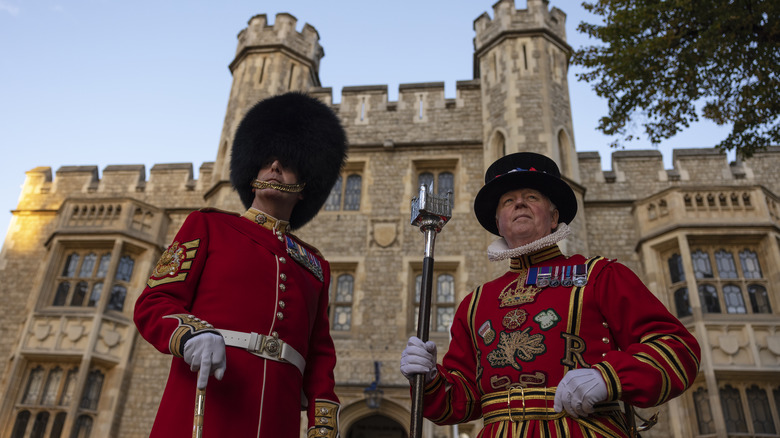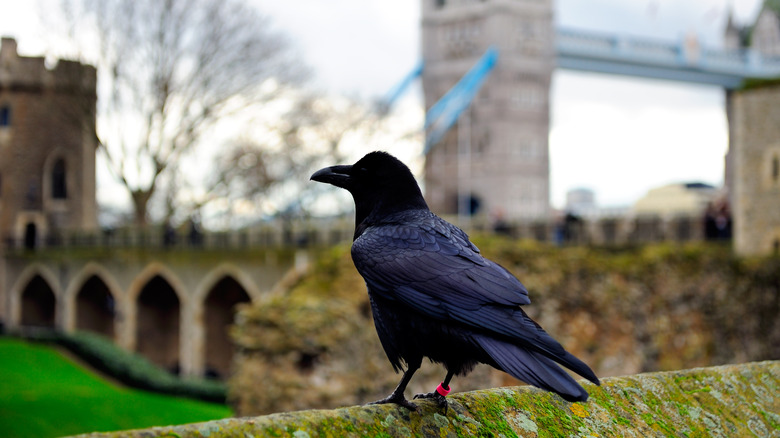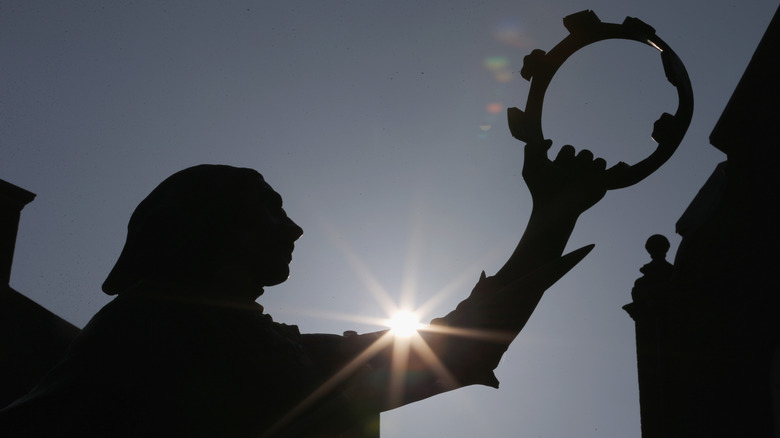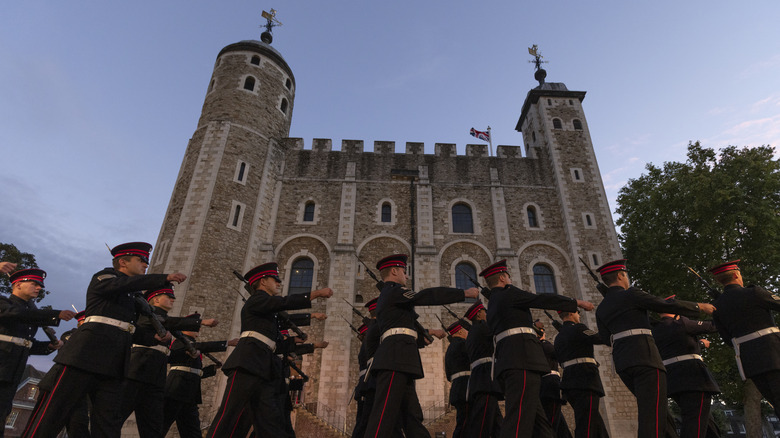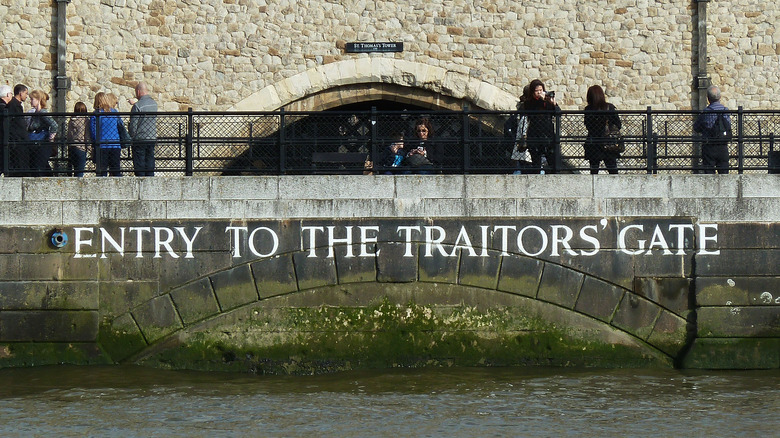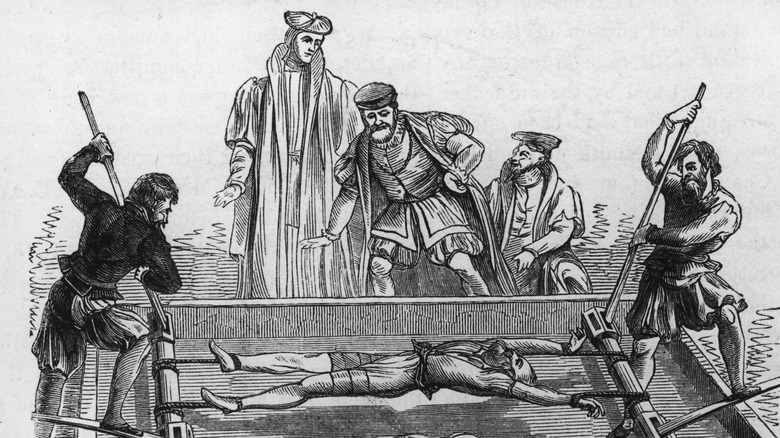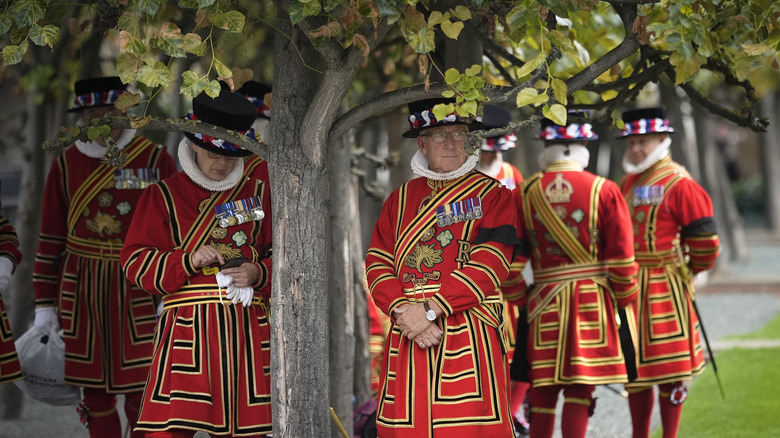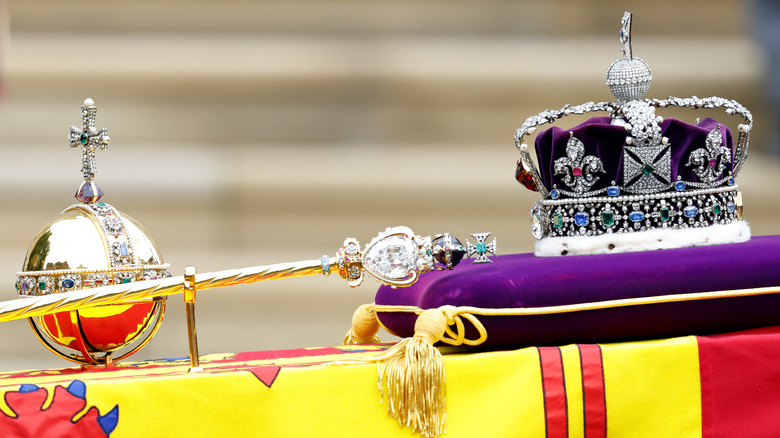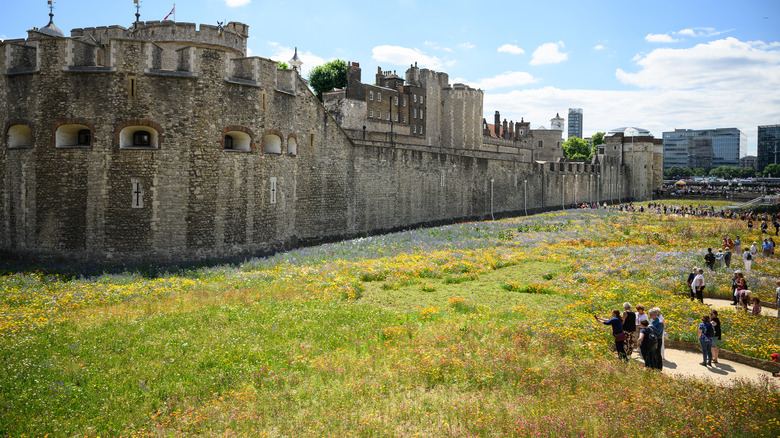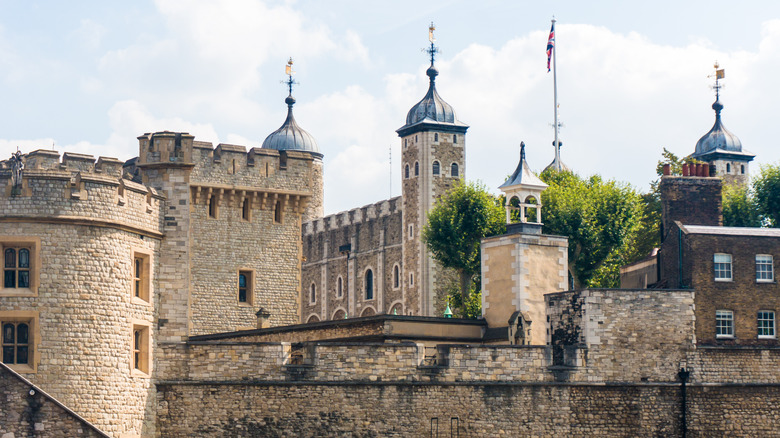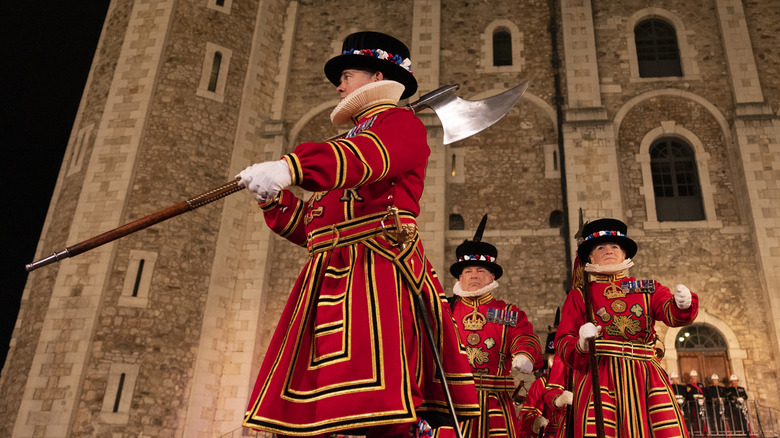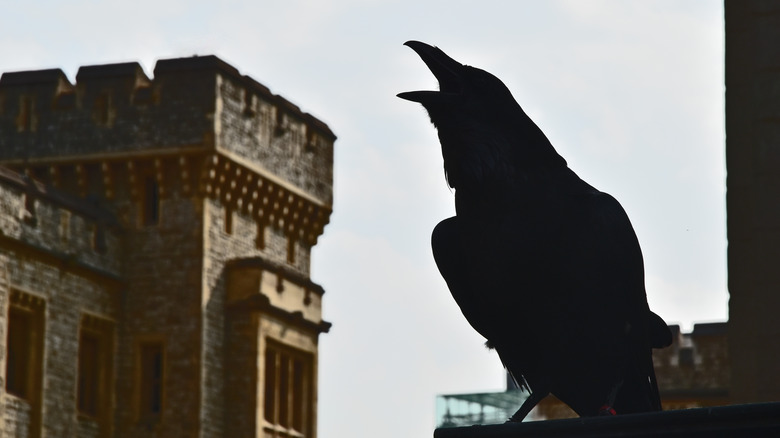Fascinating Facts About The Tower Of London
You could say towers have their heads in the clouds and a habit of looking down upon the rest of the world. They are both intimidating and inspiring and tend to, well, tower over everything. Yet there's one tower that rules them all like the granddaddy of structures — London Tower. Way back when towers were primarily built for strategic and defensive reasons, William the Conqueror laid down the foundation stones for what the world would later know as the Tower of London.
According to Live Science, William was a bit anxious that after the Norman Conquest of 1066 the local Anglo-Saxons would object to him taking over their manor. And so he did what Normans would later gain a reputation for — build a bastion of bricks and mortar to keep the angry locals at bay. The Tower has outlived generations of kings and queens, survived numerous wars, fires, plagues, and plots, and still stands, shrouded in secrets and haunted by history.
Let's take a trip down the old river Thames, past Traitors' Gate, and straight into the heart of the Tower of London for an access-all-areas tour that leaves no stone unturned, or any dark corner unilluminated. Here are some fascinating facts about the Tower of London.
The site was once home to London's first zoo
According to Historic Royal Palaces, the Tower was also London's very first zoo. It was a trend for monarchs in the Middle Ages to give one another exotic animals as presents, and having a rare beast to show off in court carried a certain prestige. After being gifted three leopards In 1235 by the Holy Roman Emperor Frederick II, Henry III decided to transform the Tower into a menagerie. In 1252, Henry III was delighted to receive a polar bear from the king of Norway. Although it was kept permanently chained, it was given the freedom of the Thames to swim and fish in. Three years later the king of France sent Henry III an elephant, but like many animals at the Tower, it suffered greatly from the claustrophobic and unnatural conditions and died soon after.
In the 1300s, King Edward I had a permanent den for the lions built near the Tower's western entrance. It was known as the Lion Tower until it was knocked down in the 1800s. The royal menagerie lost a lot of its pulling power by the 19th century, and it was left to head zookeeper Alfred Cops to reverse its fortunes by acquiring 300 new species. Yet the increased expense and concerns about the animals' welfare eventually led to the zoo's closure in 1835. The majority of the animals were sent to a new home in Regent Park, which led to the formation of London Zoo.
Six ravens live there to maintain the monarchy
Although all the zoo animals have left the Tower, the ravens remain. Something which the royal family has a vested interest in because there is an old superstition that "if the ravens leave the tower, the kingdom will fall," according to Historic Royal Palaces. It was Charles II who issued the royal decree that the Tower must have six resident ravens at all times after he was warned the crown and Tower would fall into ruins should the ravens take flight. Known as the guardians of the Tower, the ravens are technically captive. Their flight feathers are regularly trimmed in an effort to discourage the birds from leaving, but in reality, as Historic UK notes, this upsets their balance and makes long flights challenging.
Yet although pampered by the ravenmaster with a steady diet of rodents, chicks, raw meat, the occasional rabbit, and blood-soaked biscuits, in the past some ravens have heeded the call of the open skies and flown their gilded cage. The superstition of the ravens and the Tower probably has its roots in Celtic mythology where the raven is a symbolic and powerful bird hailed for its protective powers (via Atlas Obscura). Historic UK reports that during World War II, a solitary raven named Grip was all that stood between the monarchy and its downfall. In the face of nightly bombing by the Luftwaffe, the other birds couldn't cope and left Grip to man the fort alone.
Richard III is rumored to have killed his nephews at the Tower
The Tower of London was a luxurious royal residence for 500 years (via Historic Royal Palaces) and housed many a monarch. Yet to both rich and poor alike, its thick stone walls and formidable structure were a prison. In Tudor times, it was the equivalent of the United Kingdom's most notorious maximum security jail. Anyone presenting a threat to the well-being of the state was sent here, often tortured and sometimes executed. Perhaps the most unfortunate prisoners in the Tower's history were the two princes Edward and Richard.
Sky History reports that after Richard, duke of Gloucester, was appointed lord protector of the realm following the death of his brother, Edward IV, his ambition to wear the crown saw him declare his brother's rule illegitimate. To consolidate his power, Richard had his nephews kept under lock and key at the Tower until the time came to have them killed. Richard allegedly sent a loyal knight and two henchmen to smother the young princes with pillows as they slept. The killings were kept a secret, and the bodies were buried in an unspecified spot, until 1674 when the skeletons of two people were unearthed at the tower and declared to be that of the boys. Smithsonian reports that although organizations such as the Richard III Society have maintained his innocence, written testimony and the body of evidence suggest the old king has the blood of innocents on his hands.
Guy Fawkes, Rudolf Hess, the Kray twins, and Anne Boleyn were all imprisoned there
Richard III's nephews were far from being the most historically famous ever to do time in the Tower of London. Gangsters, a Nazi, a revolutionary, a knight and even the wives of a king have looked at the world from behind the Tower's foreboding bars. History reports that in the wake of his foiled gunpowder plot to blow up the House of Lords, Guy Fawkes was imprisoned in a notorious cell in the Tower named "Little Ease." The cell was so tiny no occupant could stand or lie fully. After days of grueling torture, Fawkes was sentenced to death. Following his capture in Scotland, Deputy Fuhrer Rudolf Hess was confined in the Tower for a few days on the orders of Winston Churchill
Before their names became synonymous with the East End underworld, Ronnie and Reggie Kray also enjoyed the dubious distinction of being banged up in the Tower. The Mirror reports that the twins' crime was dodging national service. One of the Tower's most high-ranking and longest-serving prisoners was Sir Walter Raleigh. As History detail, the explorer and adventurer was imprisoned for hatching a plot against King James I. Raleigh served 13 years in the Tower in quite comfortable conditions and even found time to write a book and father a child. Henry VIII also condemned two of his wives to the Tower. Both Anne Boleyn and Catherine Howard would be imprisoned and beheaded there.
The Tower once held notorious sorcerer Hew Draper
Just like a cowboy needs a horse and a witch needs a broomstick, every wizard needs a tower to call their own and look mysterious in. If ever there was a building that needed a resident sorcerer, it's the Tower of London. According to The Guardian, in the 16th century, the Tower was home to a magician named Hew Draper. However, Draper was no guest of honor. The Bristol innkeeper was imprisoned there on charges of sorcery. My London reports that Draper was in the clink for cursing a pair of Elizabethan nobles. Although Draper later confessed to an interest in magic, he swore he had since turned his back on all occult teachings.
Yet the astrological engravings he carved into the stone walls of his cell in the Salt Tower tell a different story. Still visible today, the carvings are extremely intricate, heavily detailed, and very artistic. On one design, the convict wrote, "Hew Draper of Brystow made this sphere the 30 day of Maye anno 1561." All the carvings have a spellbinding quality and indicate that Draper had a deep knowledge and profound belief in the occult. Perhaps he thought the inherent power of the symbols could save him from a grisly end? As there is no further record of Draper's death, possible escape, or life outside of prison, it is tempting to imagine the magician pulled off a once-in-a-lifetime trick and escaped captivity with all the ease and elusiveness of Harry Houdini.
Traitors' Gate is still visible above the Thames
In the U.K., high treason can still carry a life sentence in prison, but since 1998 no one can be executed for betraying the sovereign and state (via the BBC). For centuries it was a different story. The entrance of the Tower of London, now mostly submerged by the Thames, was the route hundreds of prisoners accused of treason took to meet their terrible fate. According to Atlas Obscura, the notorious entrance was built in the late 13th century as a convenient means for King Edward I to access the Tower from the Thames. Yet by the second half of the 16th century, and with more and more people imprisoned at the Tower on charges of treason, Water Gate had become Traitors' Gate. Sir Thomas More and Sir Walter Raleigh, among others, all entered the Tower via Traitors' Gate.
When the future Elizabeth I was almost 3, as per the BBC, her mother Anne Boleyn was taken by barge allegedly through Traitors' Gate and executed shortly after. Accused of participating in the Wyatt Rebellion, Elizabeth was also condemned to the Tower by her half-sister, Queen Mary, at the age of 21. Determined not to meet the same fate as her mother, the wily Elizabeth was later freed. Whilst held captive she would take daily strolls along the battlements, which later would become renowned as Elizabeth's Walk, as per the Royal Collection Trust.
London Tower was once a notorious torture chamber
Although it attracts over 3 million visitors each year and is renowned worldwide for the weight of history it carries on its stately shoulders, the walls of the Tower of London once echoed with the despairing and harrowing cries of the tortured. Historic UK points out, although the Tower's name is often synonymous with the punishment and pain inflicted upon its prisoners, its use as a torture chamber only lasted during the 16th and 17th centuries when England was in the grip of religious turmoil. Although torture was never officially sanctioned by the state, it was often given the green light by the monarch and the privy council when all other resources to obtain what they needed to know failed. As Sir Francis Bacon once wrote, "In the highest cases of treasons, torture is used for discovery and not for evidence."
Torture in the Tower usually went in the guise of The Duke of Exeter's Daughter, the Scavenger's Daughter, and the manacles. The Duke of Exeter's Daughter or the rack would slowly stretch a poor soul's body before ripping their limbs clean from their sockets. Many prisoners would confess to everything at the mere sight of the rack. The Scavenger's Daughter or Skeffington's Irons was rarely used, but instead of stretching it compressed a prisoner's body with unbearable weight. Although lacking a fancy name, the manacles were just as punishing. They would be attached to a prisoner's wrists and used to hang them suspended off the floor for an agonizing period.
A total of 22 executions took place at the tower
Alongside torture, the Tower of London is also associated with a gruesome and blood-soaked legacy of execution. According to the Crime Museum, a total of 22 people were hanged and beheaded at the Tower. Historic Royal Palaces report that only individuals of high social standing or who curried popular favor with the public would be executed within the Tower grounds. It was feared the collective fury of the mob at the killing of a well-liked individual would cause riots. The 10 people who fell foul of the executioner's blade on Tower Green included Anne Boleyn and Catherine Howard, who were unlucky enough to have married serial philanderer and killer, Henry VIII.
Anne Boleyn who famously uttered, "I heard say the executioner was very good and I have a little neck," fell foul of the ultra-sharp blade of a highly professional swordsman who traveled from France to cut the queen's head off. The countess of Salisbury, Margaret Pole, was not so lucky. Her executioner had little in the way of finesse, and it was reported his axe savagely cut her into pieces.
According to Crime Museum, the final execution took place at the Tower in 1747. On the site of Tower Green, a memorial plaque reads, "Gentle visitor pause awhile: where you stand death cut away the light of many days" (via Historic Royal Palaces).
The King's Beefeaters continue to live at the tower
The Tower of London is a place where the past meets the present and creates something unique. It is born of history but not defined by it and is in a state of constant evolution. Unlike a lot of historical architecture, the Tower is also home to a small and lively community. According to the BBC, the Yeomen Warders who guard the crown jewels also live in the Tower. Nicknamed Beefeaters because they were paid partly in slices of prime beef, Henry VII established the Yeomen Warders to help guard the Tower and its prisoners and residents. The rest accompanied the king on his travels and became the Yeomen of the Guard, as per Britannica.
Look Up London reports that every Yeomen Warder is required to have served in the military for over 22 years and can only apply for the position between the ages of 40 and 55. A total of 37 Beefeaters and their families continue to live full-time at the Tower in a purpose-built village. The Yeomen Warders and their kin enjoy the use of historic houses, a church, a doctor's surgery, a village green, and a pub fittingly named The Keys. The pub doesn't have a barman but in the spirit of solidarity, each Beefeater takes it in turn to tend the bar, and guess what's on tap? Yeomen 1485 and Beefeater Bitter, as per Reuters. And for those in the mood for something a little stronger, there's the famous Beefeater Gin.
The Tower is home to jewels worth billions
The Tower of London isn't just a historically priceless building, it also houses the crown jewels, which are thought to be worth somewhere between $1 and $6 billion (via Reader's Digest) . The ruling monarch's extensive collection of bling has been guarded obsessively for over eight centuries. On rare occasions such as coronations, weddings, and the state opening of parliament, certain items from the collection of over 23,000 gemstones and 100-plus unique ceremonial items are allowed an airing. The collection has been amassed and added to by monarchs throughout the ages, and only the ruling king or queen, the archbishop of Canterbury, and the individual responsible for their maintenance are allowed to touch them.
Perhaps the most well-known item in the crown jewels collection is St. Edward's Crown. Commissioned by Charles II in 1661, the crown is thought to be worth $57 million. Loaded with nearly five pounds of solid gold and hundreds of precious stones, it's a headpiece fit for a queen. Elizabeth II was the last person to wear it for her 1953 coronation and commented later on how almost unbearably heavy it was. King Charles III will undoubtedly be preparing his neck muscles to take the strain when he's officially crowned in 2023.
The crown jewels are not owned by the state, and the collection that the king has inherited includes the Imperial State Crown, which was last seen by the public on the coffin of Queen Elizabeth II, the Sovereign's Orb, and the Sovereign's Sceptre with Cross.
There is rumored to be a buried stash of gold coins there
Aside from the crown jewels, there is also rumored to be a hidden hoard of gold coins buried deep in the bowels of the Tower of London. According to Steve Roud's book "London Lore," after King Charles I was deposed by the roundhead Oliver Cromwell in the English civil war, he promoted his puritan buddy and loyal supporter Sir John Barkstead to the plum role of Tower of London Lieutenant. Yet the good life for Barkestead ended when Charles II was restored to the throne. Barkstead's attempt to evade the king's wrath and flee to Germany was foiled by the authorities. He was arrested and quickly executed.
Before he went on the run, Barkestead was thought to have buried a stash of loot somewhere in the Tower. In his diary, the writer Samuel Pepys gives an account of how he participated in a 1662 treasure hunt to find the gold. After searching high and low the party began digging. Pepys wrote, "We set to it; and to digging we went til almost 8 o'clock at night — but could find nothing." Plenty of other would-be Indiana Jones have since attempted to find the buried treasure, worth over $20 million in today's currency, as per My London, including an official archeological investigation in 1957, but no one has yet been successful.
For 500 years the Tower was also the Royal Mint
Talking of money, the Tower of London literally had a license to print the stuff during its 500-year tenure as the Royal Mint. According to Historic Royal Palaces, Edward I decided to mint all the coins of the realm in the Tower from 1279 onwards. Until 1810 most coins bearing the likeness of the ruling monarch were manufactured in an area of the Tower known as Mint Street. The production of coins was hard work and carried considerable risk. Precious metals were poured into fierce furnaces for the melting process, and toxic chemicals and gases filled the air. Before 1600, all coins were forged by hand, and most workers would lose a finger or an eye in the heat and hell of making money.
Yet far worse was the punishment for tampering with any coins manufactured in the mint. Any attempt to remove any silver from the coin or illegally reproduce them would, in medieval times, see the offender's right hand cut off. Anyone stupid or brazen enough to try again would be castrated. Punishments that were meted out in later periods included hanging and being drawn and quartered for the crime of counterfeiting, and women were burned alive. In 1699 the renowned scientist Issac Newton was made master of the Mint for his work in bringing counterfeiters to justice.
The Ceremony of The Keys has been staged every day for 700 years
Rituals, traditions, and ceremonies are all part and parcel of life's rich tapestry. Yet there are not many ceremonies that have been enacted nearly every night for seven centuries, such as the Ceremony of the Keys. According to Historic Royal Palaces, the gates of the Tower of London have been ritually locked and unlocked since a cold night in December 1340, when Edward III was angered to find that his entrance into the Tower went unchallenged. The constable who was on duty was imprisoned for his tardiness, and the king insisted from then on the Tower gates would be locked in the evening and opened at the break of dawn.
The chief Yeoman Warder has to carry the keys and lock the inner and outer gates of the Tower. The warder wearing his traditional red garb and Tudor bonnet is flanked in his duty by a military escort, and since 1826 the ceremony always takes place from seven minutes to 10 p.m. It ends with the warder exclaiming, "God preserve King Charles" or whoever is the ruling monarch at the time. The guard on duty cries "Amen" as the clock strikes 10, and "The Last Post" is played.
Paranoid and anxious about her security, the unpopular Queen Mary had the Ceremony of the Keys written down in text for posterity. Apart from the duke of Wellington changing the time of the ceremony from sunset to 10 p.m. when he was Tower constable, the ceremony has remained unchanged, even when a German bomb struck the Tower in 1940.
The Tower is said to be haunted
You'd expect at least a few headless horsemen and mysterious ladies in white to be rattling their chains and hanging about in the vicinity of the Tower of London. According to Great Castles, the Tower, which has been described as England's spookiest building, does not disappoint. Presumed murdered by their power-hungry uncle, Richard III's nephews Edward and Richard have often been spotted in the rooms where they were held captive, clutching one another tightly and whimpering in terror. Whenever they are approached the two nervous youngsters simply disappear into the waiting walls.
Regal victims such as Anne Boleyn and Lady Jane Grey have both been sighted wandering headless and lost in the Tower. Exploring Castles points out that in 1864 a sentry was so overcome with fear at the sight of a decapitated Boleyn, he fainted. Spare a thought for poor old Margaret Pole, the plucky lady who refused to kneel before her death blow and was subsequently hacked to pieces. Yet her torment continues as witnesses have described seeing her ghost chased through eternity by a savage and merciless executioner. Other otherworldly visions such as a woman in white who guards the keep and wears a repugnant perfume, phantom horses with demonic red eyes, and a haunted suit of King Henry VIII's armor are also said to haunt a Tower whose secrets are legion.
